Table of contents
 Eva Lendel
Eva Lendel
What types of fabrics are used to make wedding dresses? If you are in search of your dress, having knowledge -even if it is basic- of the universe of fabrics will always be a great help, especially if you plan to have it made. But, what are the best fabrics for a wedding dress? Here we show you the various alternatives so you can make an informed choice.
1. Lightweight fabrics
If you don't know what fabrics wedding dresses are made from If you are looking for a dress with a flowing skirt or a boho chic style, you will learn that these are the most used fabrics for dresses in spring/summer season because they are light and very comfortable, ideal if you are looking for a dress with a flowing skirt or a boho chic style.
1. Gauze
 Ronald Joyce
Ronald Joyce
It is a fine and light fabric for wedding dresses. It is characterized by its fluid movement and low density, making it ideal for flowing and ethereal wedding dresses. If you are getting married in spring-summer, this fabric will suit you as it is fresh and very versatile. It is also widely used in the creation of accessories such as tails and capes.
2. Tulle
 Nova Mile
Nova Mile
It is a type of fabric net-shaped, light and transparent Made from multifilament yarn, either from natural fibres such as silk, artificial fibres such as rayon or synthetic fibres such as nylon, tulle has a rough texture and a mesh-like appearance and is widely used, for example, to make veils or voluminous layered skirts.
Moreover, being a relatively hard fabric, it keeps its shape intact throughout the day and can be easily transported without warping or wrinkling. There are different types, such as plumeti tulle, shiny tulle, draped tulle, pleated tulle and illusion tulle, among others.
3. Organza
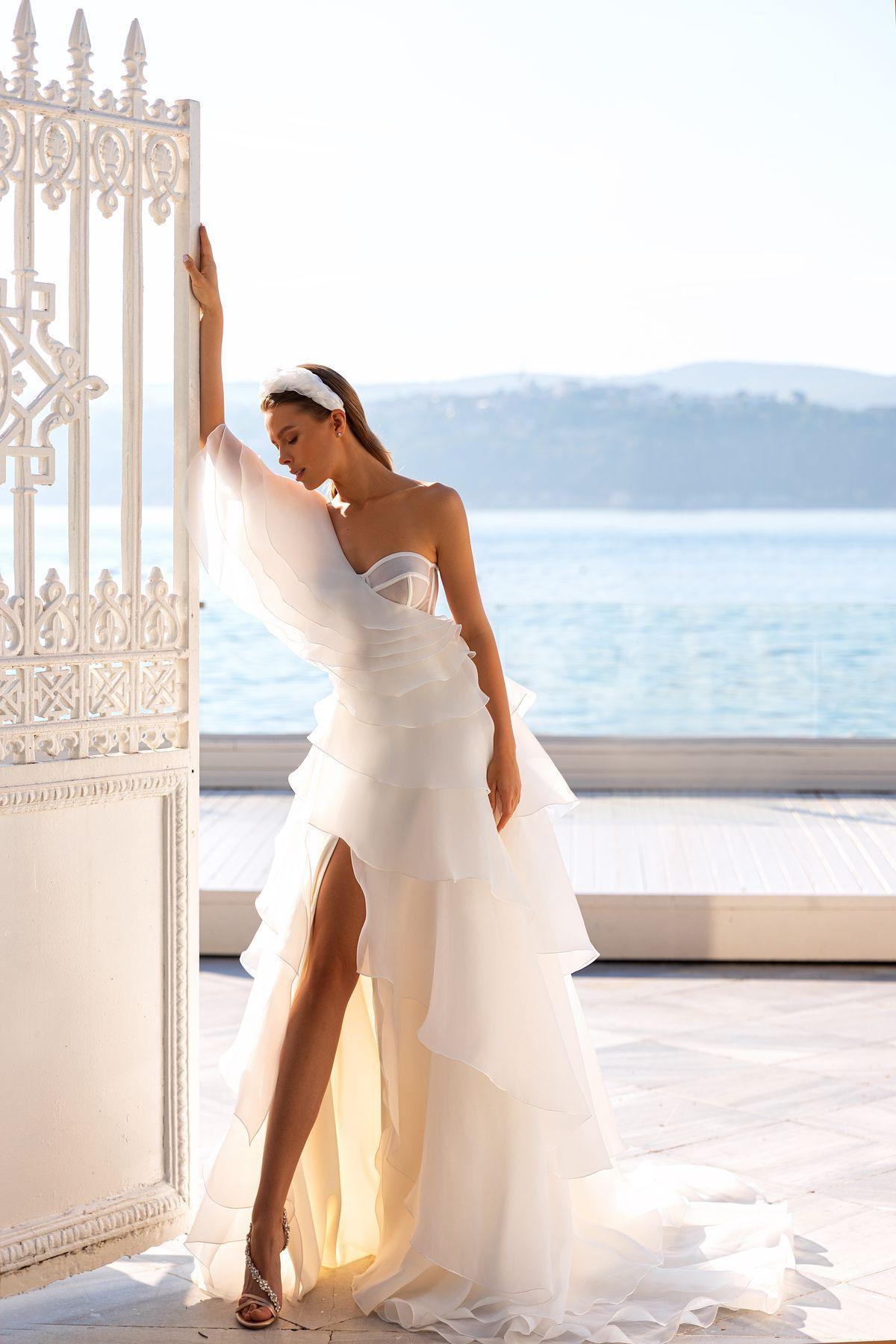 Daria Karlozi
Daria Karlozi
Corresponds to a light dress fabric, made of silk or cotton. With a starched appearance, the organza can be found smooth, opaque, shiny and satin, being especially recommended for shaping the figure.
This fabric can also include subtle embroidery, usually with floral motifs, a delight for the most romantic brides.
4. Chiffon
Light and soft in texture, the chiffon is made from cotton, silk or synthetic fibres The fabric is similar to a fine net or mesh, which gives the fabric its translucent properties, making it perfect for wedding dresses that can be layered and veiled.
5. Bambula
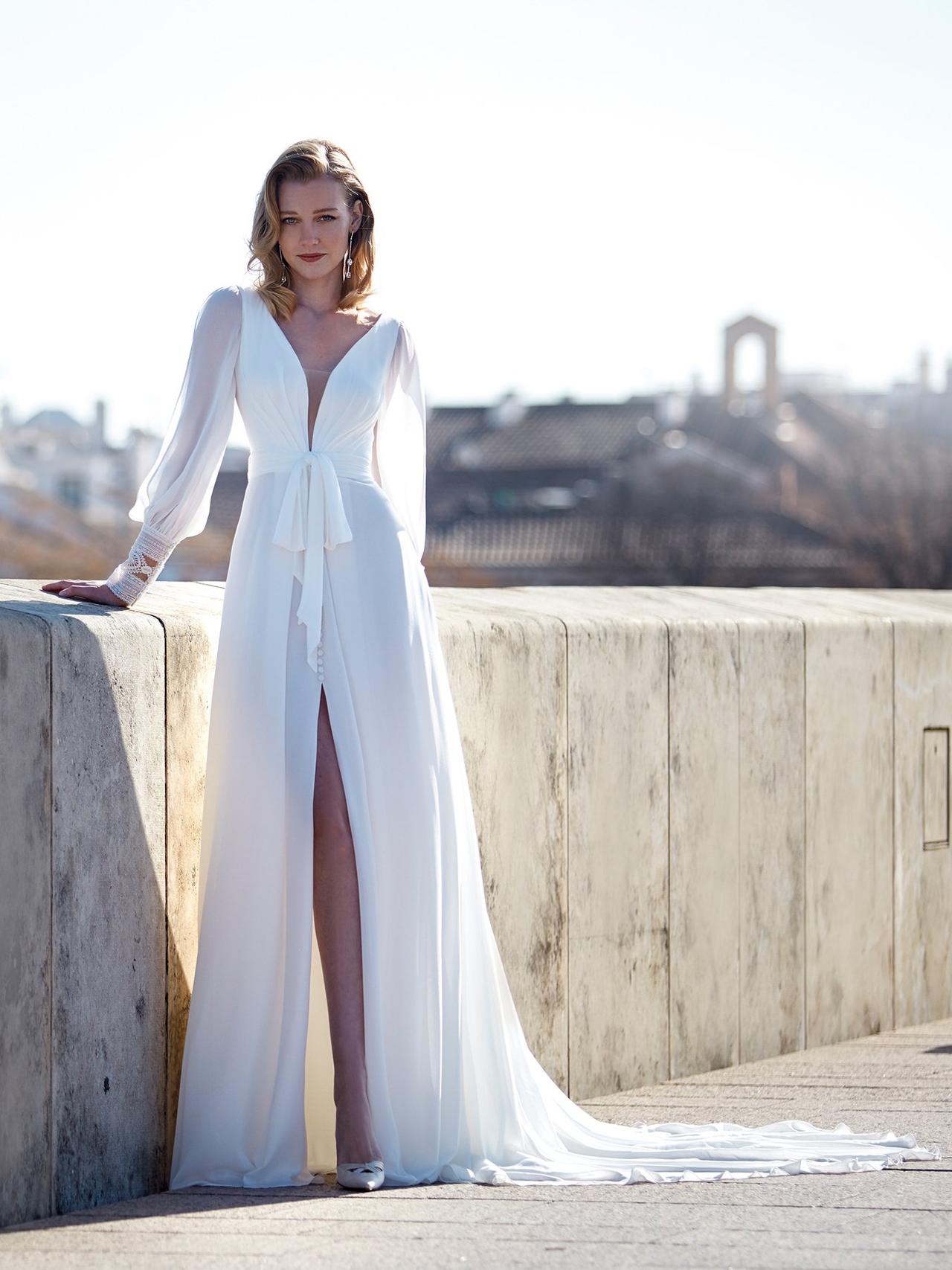 Manu Garcia
Manu Garcia
If you are looking for a comfortable, fresh and loose wedding dress, an excellent option will be to choose one made with bambula. very lightweight cotton, silk or synthetic fibre fabric The system of making it produces permanent pleats or a wrinkled effect that does not require ironing. Also ideal for making hippie chic or boho-inspired wedding dresses.
Georgette
It is about a fabric for wedding dresses made from natural silk and, although it is not visible to the naked eye, it has a slightly wrinkled surface, as it uses threads with a high degree of twisting. It is a fine, light and elastic fabric, slightly translucent and can be embroidered.
7. Charmeause
It is a very soft and light textile, based on silk or polyester thread, woven in satin. The Charmeuse has a glossy front and an opaque back side While silk and polyester may be indistinguishable, the affordability of polyester charmeuse makes it a more cost-effective option, and polyester is stronger and easier to clean than silk.
8. Crepe
It is a fabric for smooth wedding dresses, which can be made of wool, silk, cotton or polyester, with a grainy appearance and a slightly rough surface, with a matte finish. It is a soft and drapey fabric It is opaque on one side and with a natural shine on the other. It also fits the skin, achieving a very good demarcation of the bride's silhouette. Reversible and versatile, you will find it in different types: crepe de Chine (smooth), crepe Georgette (grainy), crepe Moroccan (wavy), crepe pleated (corrugated) and crepe wool (fibrous).
9. Gazar
Corresponds to a fine natural silk fabric It is similar to organza, but more dense, rigid and less transparent. It is widely used, for example, for the fall of a long skirt with a train.
2. Types of lace
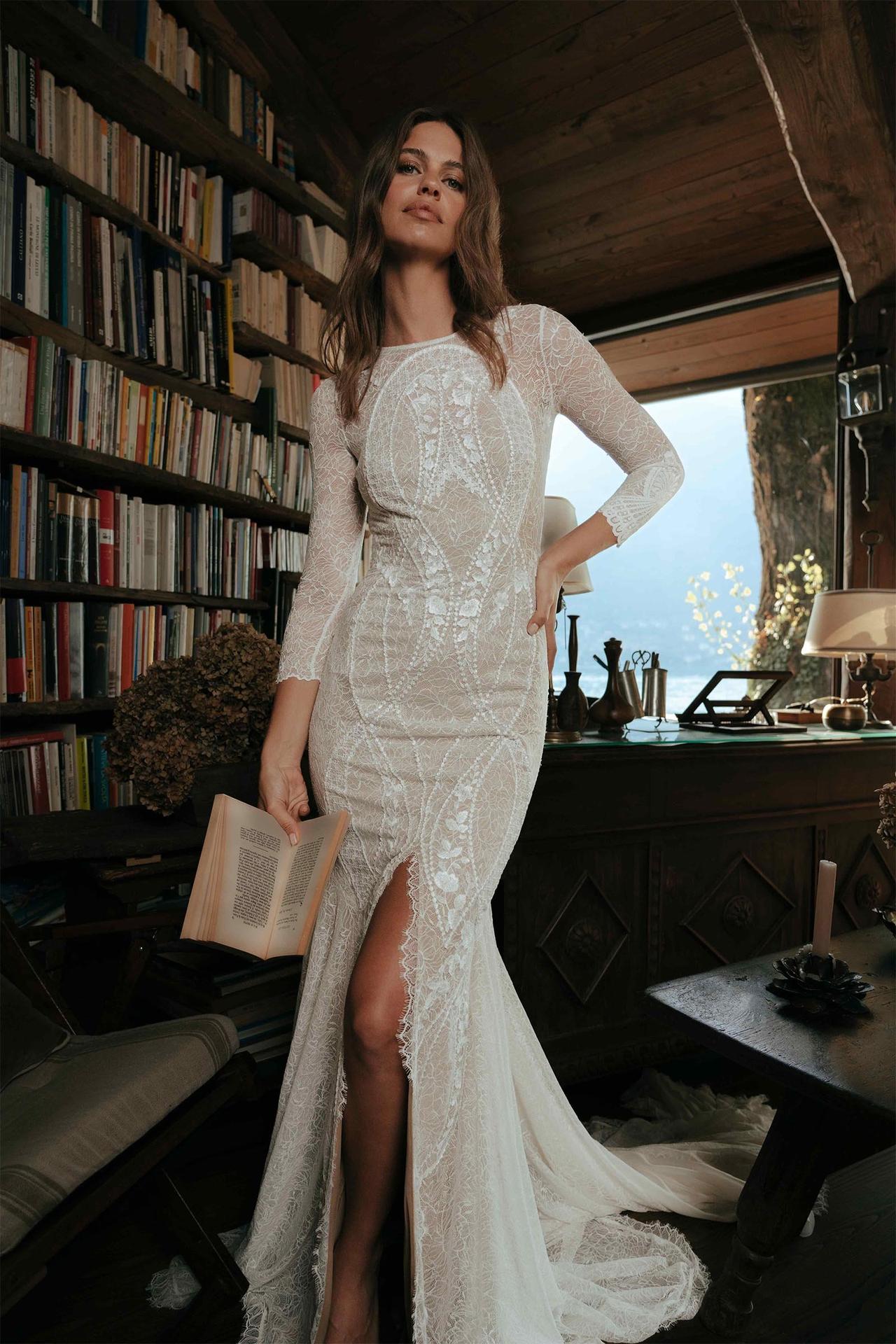 Grace Loves Lace
Grace Loves Lace
It is a romantic and seductive fabric and also, very varied. Corresponds to a fabric made of silk, cotton, linen or metallic threads Therefore, you can choose a wedding dress with full lace, or reserve this fabric for specific areas, such as the neckline or the back. You will find different types of lace:
10. Chantilly lace
It is a lace made of by hand with bobbins It is one of the finest and most appreciated in bridal fashion.
 MISS KELLY BY THE SPOSA GROUP ITALIA
MISS KELLY BY THE SPOSA GROUP ITALIA
11. Alencon lace
This lace is slightly thicker than the Chantilly lace and it is edged with a fine cord called cordoné .
 Marylise
Marylise
12. Schiffli Lace
It is a lightweight lace with embroidered designs on the interwoven fabric .
13. Guipure lace
Of coarse mesh, it is characterised by has no bottom That is to say, the motifs are held linked together or joined with thrown threads.
 Fara Sposa
Fara Sposa
3. Heavy or medium-weight fabrics
These fabrics are usually used in princess cut wedding dresses or straight and elegant cuts. Their exquisite quality makes them one of the most used fabrics for wedding dresses both today and in the past.
14. Pique
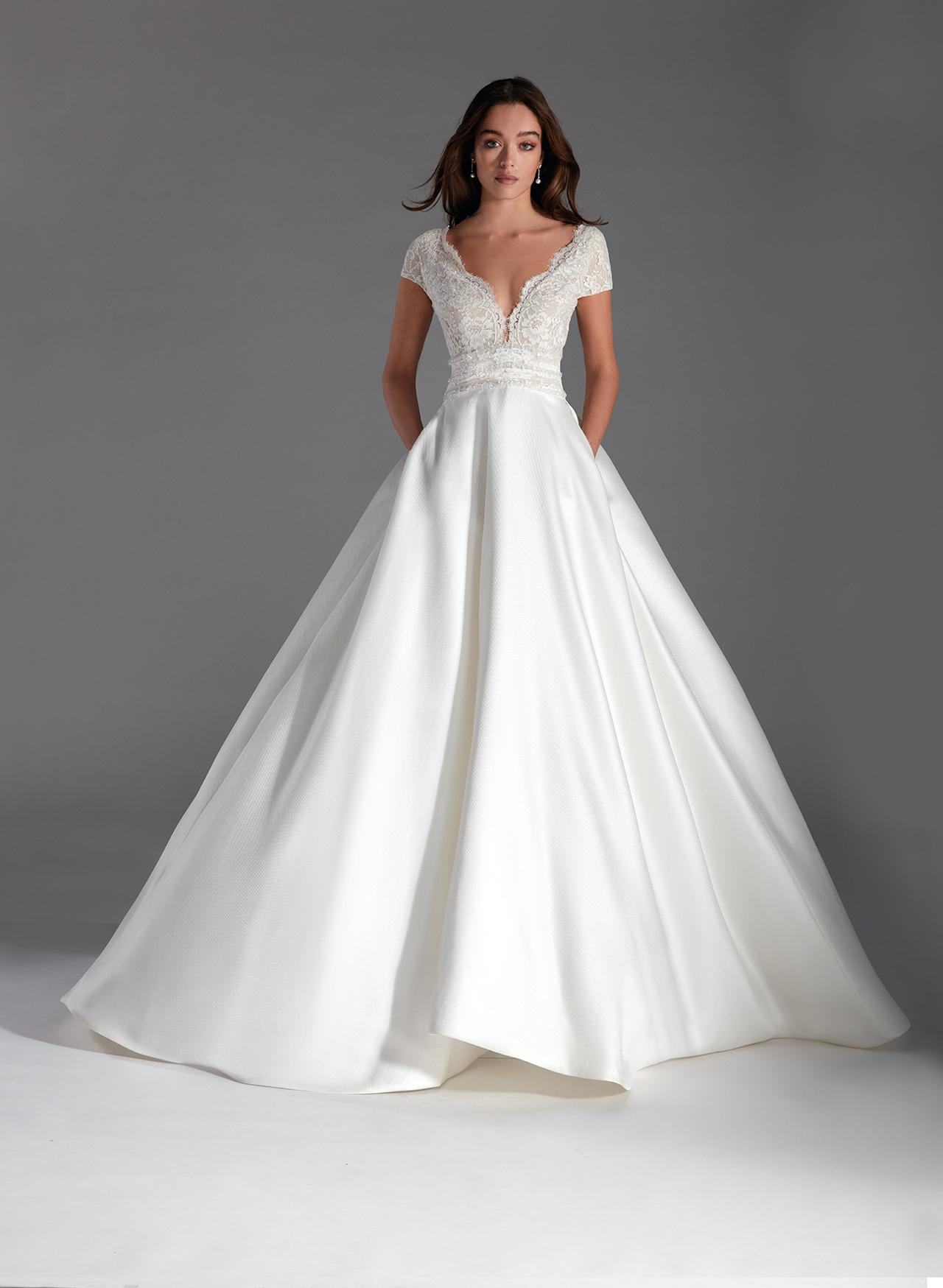 Hannibal Laguna Atelier
Hannibal Laguna Atelier
It is a fabric of cotton or silk with embossed texture Piqué, usually in the form of a mesh, rhombus or honeycomb, formed by fractions of 12 by 12 threads. Slightly rough and with a starched appearance, piqué is ideal for classic and voluminous wedding dresses.
15. Shantung
Originating in the Chinese province of the same name, it is made in with irregular silk threads and has a shiny reverse side It is very similar to Dupion because of the knots in the weft, but it is cheaper, has a crunchy texture and does not wrinkle. It can even be iridescent.
16. Dupion
Also known as "wild silk", it corresponds to a silk fabric with imperfect yarn It is a medium weight fabric with great body, texture and shine, which although it is very sophisticated, it has the disadvantage of creasing easily.
17. Failure
Or faille in French, is a silk fabric, medium-high weight, soft, shiny and with an excellent drape. It is woven with fine silk thread in the warp and chapé silk thread in the weft. It has neither straight nor purl, while the iridescent effect is achieved by mixing threads of different colours in the weft and warp. It is a rigid fabric and therefore perfect for fitted wedding dresses, whether short or in mermaid silhouette.
Mikado
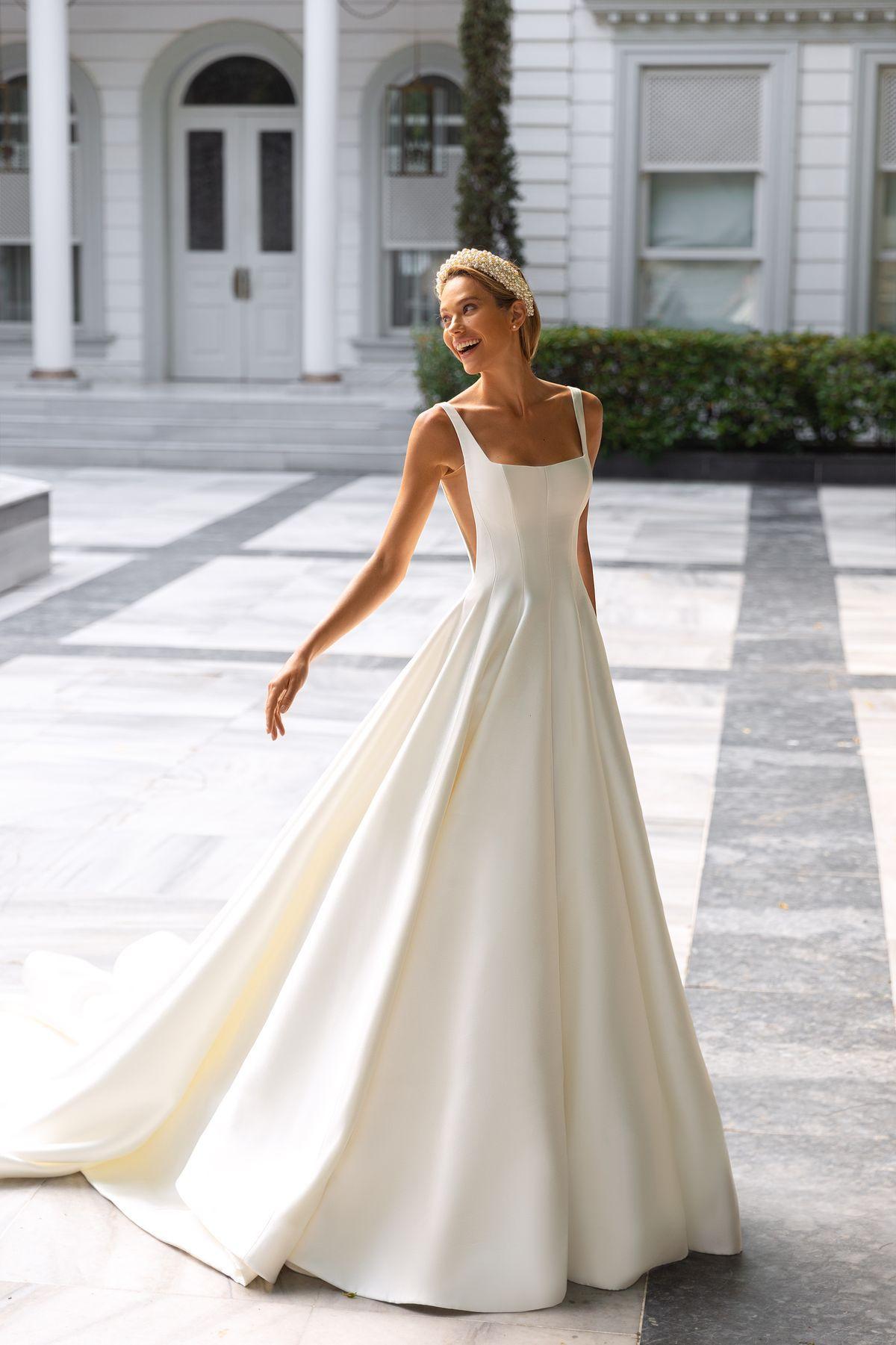 Daria Karlozi
Daria Karlozi
Made from thick natural silk, it is a full-bodied fabric with a slightly grainy texture Due to its stiffness, it enhances the lines of the cut very well and slims the figure. In addition, it does not crease easily and is a particularly elegant fabric, with a less shiny finish than satin. It is perfect, for example, for princess-style wedding dresses in the autumn-winter season.
19. Ottoman
A coarse weave of silk, cotton or worsted fabric, whose corded texture, in the horizontal direction, is produced because the warp threads are much thicker than those of the weft. It is a very thick textile. pleasant to the touch and scratched appearance to the eye It is originally from Turkey, resistant and full-bodied.
20. Satin
 Daria Karlozi
Daria Karlozi
It is a fabric made of cotton, rayon or polyester, whose fibers are separated, combed or stretched to achieve the silky effect. With a glossy surface and a matt or opaque backing It corresponds to an elegant, soft, full-bodied fabric that can also be embroidered. It is usually sheathed, for example, in lingerie wedding dresses, to which it gives a very sensual touch.
21. Taffeta
Corresponds to a fabric formed by the crossing of threads It is usually made of silk, although it can also be made with other materials such as wool, cotton and even polyester. It is a soft fabric, but slightly stiff, being somewhat crisp to the touch. Its appearance is shiny and perfect for A-line skirts and to create drapes. There are several types such as single taffeta, double taffeta,glacé taffeta, lustre taffeta, and touch taffeta, among others.
22. Satin
It is a fabric of lustrous silk in its highest quality It has more body than taffeta, and is shiny on one side and matte on the other. Soft, uniform, smooth and compact, it adds a touch of majesty to the wedding dresses it covers.
23. Brocade
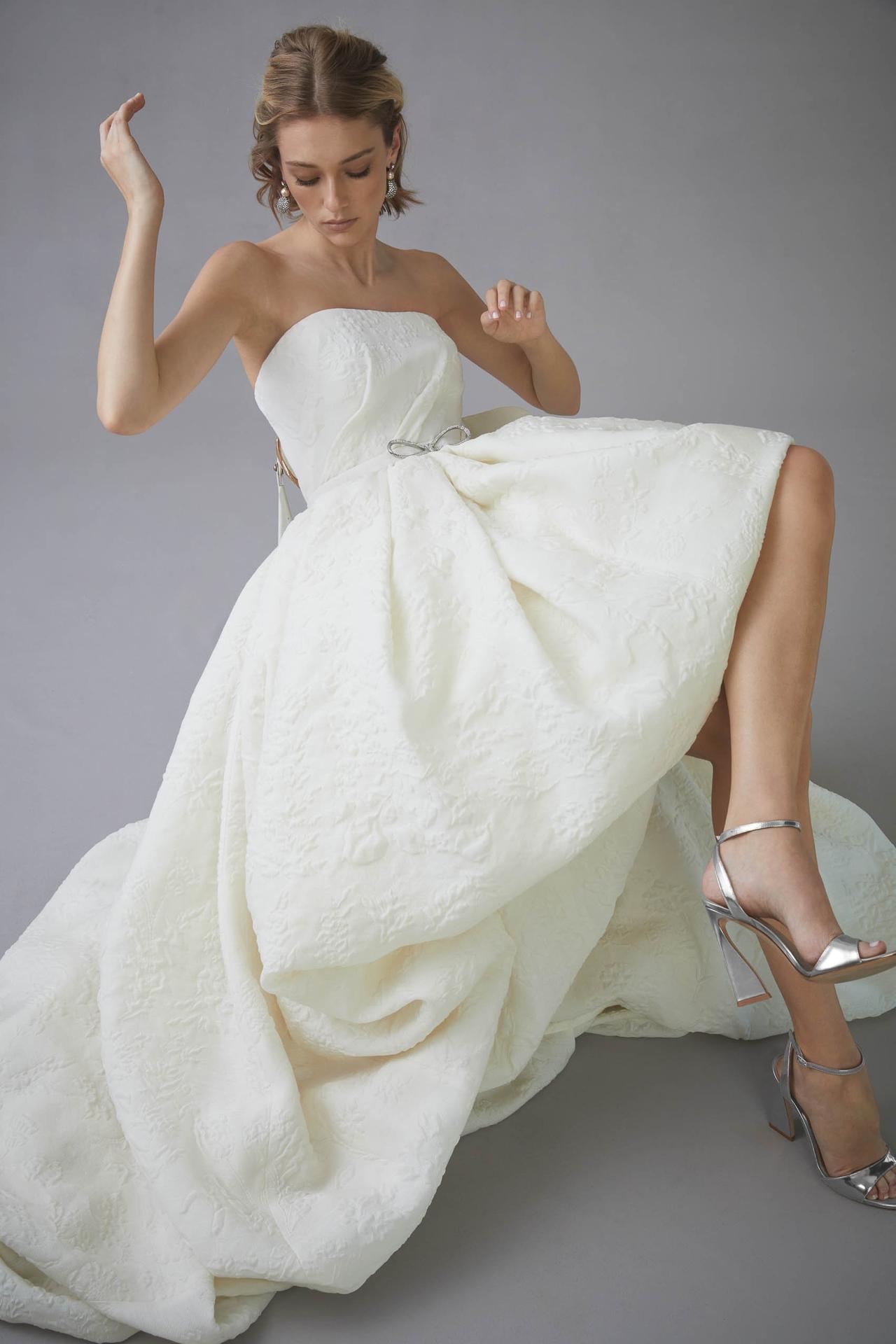 Oscar de la Renta
Oscar de la Renta
Original from Persia, it is a fabric of silk interwoven with metal threads (gold, silver) or shiny silk threads It is a thick, dense, medium-weight fabric, ideal for brides who want to look elegant and ornate. Brocade is soft and velvety to the touch, and is ideal for brides who want to look elegant and ornate.
Once you have clarified the different fabrics, you will be able to successfully distinguish between a light wedding dress made of chiffon or a dense gown with sleeves made of ottoman. Since certain fabrics blend with others, it is not really a simple task, but having this information will help you to know which wedding dress you want for your wedding day. And now with this informationask the designer how many meters of fabric you need for a wedding dress.
We help you find the dress of your dreams Ask for information and prices of dresses and accessories to nearby companies Check prices
